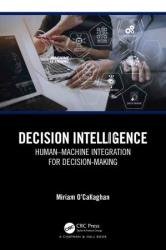 Название: Decision Intelligence: Human–Machine Integration for Decision-Making
Название: Decision Intelligence: Human–Machine Integration for Decision-MakingАвтор: Miriam O’Callaghan
Издательство: CRC Press
Год: 2023
Страниц: 280
Язык: английский
Формат: pdf (true)
Размер: 10.2 MB
Revealing the limitations of human decision-making, this book explores how Artificial Intelligence (AI) can be used to optimize decisions for improved business outcomes and efficiency, as well as looking ahead to the significant contributions Decision Intelligence (DI) can make to society and the ethical challenges it may raise.
From the theories and concepts used to design autonomous intelligent agents to the technologies that power DI systems and the ways in which companies use decision-making building blocks to build DI solutions that enable businesses to democratize AI, this book presents an impressive framework to integrate artificial and human intelligence for the success of different types of business decisions.
Advanced technologies such as Artificial Intelligence (AI) play a crucial role in how we humans as a species are evolving. We invented state-of-the-art solutions to gain and create knowledge, build systems, and design products, processes, and infrastructure that make our lives more convenient, better, and happier. Today, AI affects almost every aspect of our lives, including how we make decisions. The field of Decision Intelligence (DI) has emerged to democratize AI for effective decision-making. DI deals with applying technology, especially AI, to enhance individual and organizational decision-making potential. DI solutions integrate technological capabilities with decision-making theories, tools, and techniques to create systems that help us make better decisions more efficiently. This chapter introduces the fundamental concepts of DI. We will discuss some key questions, including what DI is, why we need it, how it works, and how it looks within the organization’s information and data architecture scheme. This chapter also covers the state of DI adoption across different businesses, highlighting factors that drive or restrain organizations from adopting DI technologies and frameworks for decision-making.
Machine Learning (ML) is a form of AI that mimics intelligent ways humans learn to behave. It is usually called a subset of AI. Most of the AI programs that companies deploy today are most likely using ML algorithms so much that the terms AI and ML are often used interchangeably. ML algorithms have the capacity to improve on their own as they gain more experience and are fed with more data. ML enables computers to decide and act without being explicitly programmed for every single task. So, how does it actually work? It starts with collecting data in various forms, including text, photos, files, sensor data, reports, or transactions. This data is prepared to be used as training data – the information the ML model will be trained on. The prepared data is fed to a suitable ML model that trains itself on this data to find patterns or make predictions. The more data, the better your results will be. Some of the data is held out from the training data for evaluation and to test how accurately the model performs when it is shown new data. If the model fails to produce accurate results, programmers can tweak the model and even change the parameters to produce more accurate results and closer to reality.25 ML systems could be descriptive (results explain what happened), predictive (predict what will happen), or prescriptive (make suggestions about what action to take).
The algorithms drive the actual functioning of neural networks and other ML models. Algorithms perform the actual ML tasks such as pattern recognition, enabling learning from data and improving the model. ML systems take their instructions through these algorithms. We will now discuss a few examples of ML algorithms in three ML subcategories – supervised, unsupervised, and reinforcement learning. We will also explore how classical ML models help decision-making and how Deep Learning (DL) further strengthens the capabilities of AI systems.
Replete with case studies on DI applications, as well as wider discussions on the social implications of the technology, Decision Intelligence: Human–Machine Integration for Decision Making appeals to both students of AI and Data Sciences and businesses considering DI adoption.
Скачать Decision Intelligence: Human–Machine Integration for Decision-Making